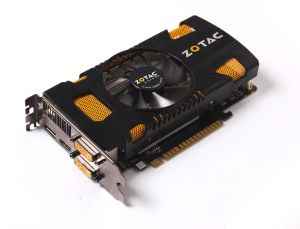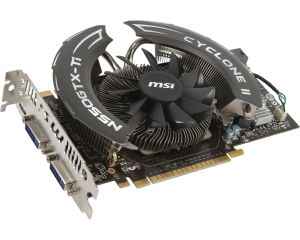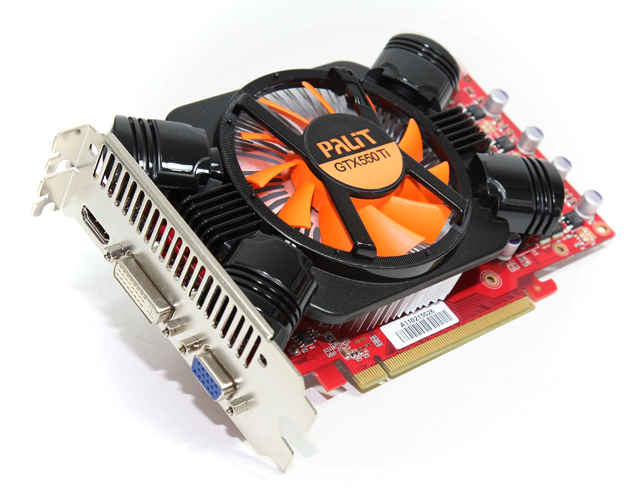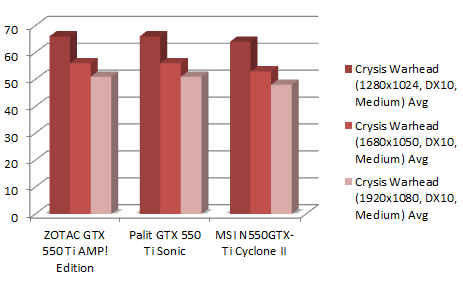New kids on the slot: GTX 550 Ti Shootout

Gamers the world over and more so in India are looking to buy GPUs in that ever elusive sweet spot, which lies somewhere in between entry level favourites such as the HD 5670 and superlative dual GPU biggies ( that burn a hole not just in your pocket but even your undies. The price range that this categorisation leaves us with is quite large. We’re looking at a wide spectrum that stretches from Rs. 5000 all the way upto Rs. 15,000. The second half of this range has contenders in the form of the newly released GTX 560 Ti, older GTX 460s and plain vanilla HD 6870s etc. But what about the first half? Even today it consists of highend GPUs of yesteryear that are still digging their heels firmly in the market (but are surely on their way out). Yes you have a stray HD 5770 creeping in every now and then, but what if you want newer architectures, newer technology behind your GPU? NVIDIA perhaps hopes to plug this very hole with its GTX 550 Ti.
The GTX 550 Ti is built around the GF116 chip which first debuted as the GF106 chip for the GTS 450. They are architecturally the same, but the difference between the two is that for the GTX 550 Ti, it’s fully unlocked in terms of ROPs, and memory controllers. This “unleashing” or rather unlocking of certain sections of the GPU chip allowed the card to have a higher base clock. The hike in memory size over the predecessor has to do with restructuring the drivers. As far as no of shader units go, the 550 Ti and GTS 450 have the same – 192. The tweaks also allow an enhanced memory interface, pegged at 192-bit (from 128-bit), and reference core clock speed pushed to 900 MHz(from 783MHz)
But enough with the gyan, let’s get straight down to our test.
The Cards
We got three cards fresh off the fab, and all three are factory overclocked versions. First up, we have ZOTAC’s 550 Ti AMP! Edition. The “AMP” nomenclature implies that it’s a souped-up edition with a few tweaks. ZOTAC has taken the core clock up by 100 MHz and the Memory Clock to 2100 from a stock speed of 1026. These are jumps of roughly 11 percent and 7 percent respectively; quite a bit when it comes to overclocking. The card looks snazzy and very much like the 560 Ti AMP we tested a couple of months earlier, except smaller. It comes with 2 DVI ports, an HDMI port and oddly enough a display port – the only one amongst the three.
In terms of design the MSI card was the most flamboyant with it’s Cyclone heat sink. It’s got two heat pipes enclosed in fins that jut out considerably. The fan is supposed to be propeller blade inspired resulting in 20 percent more airflow. Overkill or enhancer?
Find out in the performance section. As for the tweaks in specification, the N550GTX Cyclone II, is the least overclocked – a mere 50 MHz boost on Core clock and 100 on Shader as opposed to 100 and 200 respectively on the other two cards. The Palit card had a nice looking design with a VGA out as its major differentiator.
|
Brand |
ZOTAC |
Palit |
MSI |
|---|---|---|---|
|
Model |
GTX 550 Ti AMP! Edition |
GTX 550 Ti Sonic |
N550GTX-Ti Cyclone II |
|
Type of memory / Memory Clock |
GDDR5 / 1100 MHz |
GDDR5/1100 MHz |
GDDR5/1026 MHz |
|
Core / Shader Clock (MHz) |
1000 / 2000 |
1000 / 2000 |
950 / 1900 |
|
No. of Stream Processors |
192 Cuda Cores |
192 Cuda Cores |
192 Cuda Cores |
|
Memory size (MB) / Memory Interface |
1024 / 192-bit |
1025 / 192-bit |
1026 / 192-bit |
|
Connects on card |
2 x Dual Link DVI, HDMI, Display Port |
Dual link DVI, VGA, HDMI |
2x Dual Link DVI, Mini HDMI |
|
Bundled |
Molex to 6-pin |
Molex to 6-pin |
DVI adaptor, Mini-HDMI to HDMI |
How we tested
We ran a choice of synthetic as well as game benchmarks on the cards. The gaming benchmarks pushed the cards to the very limits of what are acceptable or playable framerates. We tried to push in as much AA as possible without screwing up framerates too badly. What we realised was that this card can handle both 1680 x 1050 and 1920 x 1080 with a dash of AA and other eye candy. All benchmarks at different settings were given weights which added up to the final score.
| Processor | Intel Core i7 965 @3.2 GHz |
| Motherboard | Intel DX58SO |
| Memory | 2x2GB Corsair DDR 3 @ 1333 MHz (9 9 9 24) |
| HDD | 300GB Western Digital Velociraptor |
| PSU | 620 w Corsair HX620 |
| GPU | MSI GeForce GTX 550 Ti Cyclone II 1GB |
| Zotac GeForce GTX 550 Ti AMP! Edition 1GB | |
| Palit GTX 550 Ti Sonic 1 GB |
Synthetic tests were given 20 percent weight, while 70 percent was distributed amongst the other real world test. Benchmarks which resulted in more variance between the scores (usually with settings turned down) were given higher weight. These then influenced the overall score more than say S.T.A.L.K.E.R : Call of Pripyat (Day, 1680×1050, 4xAA, DX11, Ultra Detail) which gave out near identical scores. Load temperature was also assigned a score and its weight accounted for 5 percent of the overall score.
Performance
The performance was so eerily neck and neck that we began to wonder why we ran this test at all. Scores for the two higher overclocked cards (Palit and Zotac) were nearly identical. MSI as expected gave lesser framerates in all games. Temperature was an interesting point to note. MSI’s Cyclone heatsink did indeed help the card dissipate heat quicker. Note that our temperature readings for load were taken a second or so after quitting the Unigine benchmark. The MSI GTX 550 Ti ran considerably cooler; about 10 degrees. The other two in the race, ZOTAC 550 Ti Amp, and Palit 550 Ti Sonic being more overclocked were hotter clocking 65 to 67 degrees at peak load. Considering the MSi card ran cooler by quite a large margin, it wouldn’t be too much of a stretch to imagine overclocking it a great deal. Especially since Afterburner, MSI’s overclocking utility, came bundled with it. All cards were uniformly noise free.
We’ll let the numbers do the talking as far as the benchmarks are concerned. To start with are Unigine scores graphs, followed by Crysis Warhead at Medium Settings. A full list of benchmarks scores available as you scroll.
|
Game Benchmarks |
ZOTAC GTX 550 Ti AMP! Edition |
Palit GTX 550 Ti Sonic |
MSI N550GTX-Ti Cyclone II |
|---|---|---|---|
|
COH:TOV (1280×1024, 4xAA, Ultra) Avg |
143.9 |
144.3 |
140 |
|
COH:TOV (1680×1050, 4xAA, Ultra) Avg |
112.7 |
113.7 |
109.1 |
|
COH:TOV ( 1920×1080, 4xAA, Ultra) Avg |
94.9 |
94.3 |
91.3 |
|
|
|
|
|
|
COH:TOV (1280×1024, 8xAA, Ultra) Avg |
139.2 |
138.7 |
135.8 |
|
COH:TOV (1680×1050, 8xAA, Ultra) Avg |
108.4 |
108.7 |
101.1 |
|
COH:TOV ( 1920×1080, 8xAA, Ultra) Avg |
89.5 |
90.3 |
88 |
|
|
|
|
|
|
FarCry 2 (1280×1024, Ultra High, 4xAA) Avg |
81.43 |
81.5 |
78.32 |
|
FarCry 2 (1680×1050, Ultra High, 4xAA) Avg |
68.68 |
68.93 |
65.94 |
|
FarCry 2 (1920×1080, Ultra High, 4xAA) Avg |
63.27 |
61.39 |
60.43 |
|
|
|
|
|
|
FarCry 2 (1280×1024, Ultra High, 8xAA) Avg |
72.83 |
73.12 |
69.62 |
|
FarCry 2 (1680×1050, Ultra High, 8xAA) Avg |
60.04 |
60.29 |
66.88 |
|
FarCry 2 (1920×1080, Ultra High, 8xAA) Avg |
51.65 |
51.83 |
52.62 |
|
|
|
|
|
|
S.T.A.L.K.E.R : Call of Pripyat (Day, 1680×1050, 4xAA, DX11, Ultra Detail) Avg |
55.6 |
55.5 |
53.2 |
|
S.T.A.L.K.E.R : Call of Pripyat (Day, 1920×1080, 4xAA, DX11, Ultra Detail) Min |
34.1 |
25.8 |
27.8 |
|
|
|
|
|
|
Resident Evil (1680×1050, 4xAA, Motion Blur on) |
91.1 |
89.2 |
85.3 |
|
Resident Evil (1680×1050, 8xAA, Motion Blur on) |
80.4 |
80.3 |
77 |
|
Resident Evil (1920×1080, 4xAA, Motion Blur on) |
78.6 |
78.5 |
75.3 |
|
Resident Evil (1920×1080, 8xAA, Motion Blur on) |
70.9 |
70.8 |
67.8 |
|
|
|
|
|
|
Crysis Warhead (1280×1024, DX10, Medium) Avg |
66 |
66 |
64 |
|
Crysis Warhead (1680×1050, DX10, Medium) Avg |
56 |
56 |
53 |
|
Crysis Warhead (1920×1080, DX10, Medium) Avg |
51 |
51 |
48 |
Some synthetic benchmarks
|
Synthetic Benchmarks |
|||
|
3D Mark Vantage (Overall) |
13659 |
13601 |
13135 |
|
3D Mark Vantage (GPU) |
10992 |
10965 |
10552 |
|
Unigine Heaven v2.1 (1680×1050, 4xAF, Max Shader, Extreme Tesellation) Score |
566 |
568 |
541 |
|
Unigine Heaven v2.1 (1680×1050, 4xAF, Max Shader, Extreme Tesellation) Frame rate |
22.5 |
22.6 |
21.5 |
|
Unigine Heaven v2.1 (1920×1080, 4xAF, Max Shader, Extreme Tesellation) Score |
520 |
520 |
495 |
|
Unigine Heaven v2.1 (1920×1080, 4xAF, Max Shader, Extreme Tesellation) Frame rate |
20.6 |
20.6 |
19.7 |
|
Unigine Heaven v2.1 (1280×1024, 4xAF, Low Shader, Normal Tesellation) Frame rate |
46.3 |
46.6 |
44.4 |
|
Unigine Heaven v2.1 (1280×1024, 4xAF, Low Shader, Normal Tesellation) Score |
1165 |
1174 |
1118 |
Verdict
This mini-test intends to tell you two things, which is the best performing GTX 550 Ti, and which is the most value for money one. Since the performance was marginally different, price plays an important factor. The most expensive card was the Zotac GTX 550 Ti AMP! Edition priced at Rs. 9,990, while coming in second for price was MSI N550GTX-Ti Cyclone II at Rs. 9,700. The cheapest 550 Ti was Palit GTX 550 Ti Sonic priced at Rs. 9,490. The best performer, inching ahead of the pack was Zotac. However when we ran our performance to price index Palit GTX 550 Ti Sonic emerged as the best value for money card amongst the three, giving 99.8 percent of the performance of best performer, at 94.9 percent of the cost. What about GPUs outside the world of the GTX 550 Ti? It might be prudent to keep a close eye on the price of GTX 460s and HD 6850s now.





